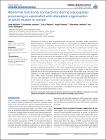| dc.contributor.author | JOHNSON, KATHERINE | en |
| dc.contributor.author | MCGRATH, JANE | en |
| dc.date.accessioned | 2014-11-27T12:38:52Z | |
| dc.date.available | 2014-11-27T12:38:52Z | |
| dc.date.issued | 2013 | en |
| dc.date.submitted | 2013 | en |
| dc.identifier.citation | McGrath J, Johnson K, O'Hanlon E, Garavan H, Leemans A, Gallagher L, Abnormal functional connectivity during visuospatial processing is associated with disrupted organisation of white matter in autism., Frontiers in human neuroscience, 7, 2013, 434 | en |
| dc.identifier.issn | 1662-5161 | en |
| dc.identifier.other | Y | en |
| dc.identifier.uri | http://hdl.handle.net/2262/72248 | |
| dc.description | PUBLISHED | en |
| dc.description.abstract | Disruption of structural and functional neural connectivity has been widely reported in Autism Spectrum Disorder (ASD) but there is a striking lack of research attempting to integrate analysis of functional and structural connectivity in the same study population, an approach that may provide key insights into the specific neurobiological underpinnings of altered functional connectivity in autism. The aims of this study were (1) to determine whether functional connectivity abnormalities were associated with structural abnormalities of white matter (WM) in ASD and (2) to examine the relationships between aberrant neural connectivity and behavior in ASD. Twenty-two individuals with ASD and 22 age, IQ-matched controls completed a high-angular-resolution diffusion MRI scan. Structural connectivity was analysed using constrained spherical deconvolution (CSD) based tractography. Regions for tractography were generated from the results of a previous study, in which 10 pairs of brain regions showed abnormal functional connectivity during visuospatial processing in ASD. WM tracts directly connected 5 of the 10 region pairs that showed abnormal functional connectivity; linking a region in the left occipital lobe (left BA19) and five paired regions: left caudate head, left caudate body, left uncus, left thalamus, and left cuneus. Measures of WM microstructural organization were extracted from these tracts. Fractional anisotropy (FA) reductions in the ASD group relative to controls were significant for WM connecting left BA19 to left caudate head and left BA19 to left thalamus. Using a multimodal imaging approach, this study has revealed aberrant WM microstructure in tracts that directly connect brain regions that are abnormally functionally connected in ASD. These results provide novel evidence to suggest that structural brain pathology may contribute (1) to abnormal functional connectivity and (2) to atypical visuospatial processing in ASD. | en |
| dc.format.extent | 434 | en |
| dc.language.iso | en | en |
| dc.relation.ispartofseries | Frontiers in human neuroscience | en |
| dc.relation.ispartofseries | 7 | en |
| dc.rights | Y | en |
| dc.subject | autism spectrum disorders | en |
| dc.subject | constrained spherical deconvolution | en |
| dc.subject | diffusion tractography | en |
| dc.subject | functional connectivity | en |
| dc.subject | mental rotation | en |
| dc.subject | neuroimaging | en |
| dc.subject | structural connectivity | en |
| dc.subject | visuospatial processing | en |
| dc.title | Abnormal functional connectivity during visuospatial processing is associated with disrupted organisation of white matter in autism. | en |
| dc.type | Journal Article | en |
| dc.type.supercollection | scholarly_publications | en |
| dc.type.supercollection | refereed_publications | en |
| dc.identifier.peoplefinderurl | http://people.tcd.ie/johnsoka | en |
| dc.identifier.peoplefinderurl | http://people.tcd.ie/sandersj | en |
| dc.identifier.rssinternalid | 98148 | en |
| dc.identifier.doi | http://dx.doi.org/10.3389/fnhum.2013.00434 | en |
| dc.rights.ecaccessrights | openAccess | |




